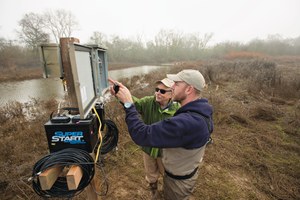Saving Salmon
Research on the Shasta River and in the Central Valley creates new knowledge to help iconic species
The rivers and streams of northern and central California once teemed with millions of salmon, mostly Chinook and Coho. But these fish are in trouble—many salmon runs are listed as either threatened or endangered. A few scientists even predict the demise of wild salmon in the Central Valley by the year 2100.
It's up to us as to whether we accept this or not," said UC Davis fisheries professor emeritus Peter Moyle. "We don't have to accept the idea that salmon are going to disappear from California."
Moyle believes there are reasons for optimism. From the slopes of Mt. Shasta to the rice fields and floodplains of the Central Valley, groundbreaking research and restoration efforts offer hope for the future of California salmon.
The secret's in the water
The Shasta River is a tributary of the Klamath River, supplying just 2 percent of the Klamath's water flow. Nonetheless, the river historically has contributed half of the Klamath's salmon. UC Davis scientists and conservationists with The Nature Conservancy and California Trout (CalTrout) have been learning more about the Shasta and working to restore its salmon runs.
"The Nature Conservancy purchased a ranch along the river and asked us to come see what gives this place its intrinsic potential for salmon recovery," said Carson Jeffres, field and lab director with the UC Davis Center for Watershed Sciences.
The center, established by Moyle and geology professor emeritus Jeffrey Mount, conducted a full-scale effort to understand water quality, stream temperature dynamics, vegetation, bugs, geomorphology, and, of course, fish. Jeffres conducted 1,500 snorkel surveys over four years to observe salmon in their native habitat.
In 2008, The Nature Conservancy fenced off its part of the Shasta and adjacent Big Springs Creek to keep cattle out of the streambed. Since then, salmon habitat has grown from less than 60 feet to more than 10 miles.
"We've illustrated that very promising results can be achieved in only a short period of time while continuing to run 500 head of cattle on the property...a model for neighboring ranches and properties beyond the region," said project manager Amy Hoss in a Nature Conservancy article.
The key to understanding the Shasta River's productivity is in the water. It is a spring-fed system—water at a constant 70 cubic feet per second and a steady 52 degrees Fahrenheit bubbles up from the earth at the Big Springs headwaters. Professor Randy Dahlgren, a UC Davis biogeochemist, explained that the water picks up nitrogen and phosphorous as it travels beneath Shasta's snow-covered slopes, which nourishes aquatic vegetation and stimulates an abundance of bugs—nature's fish food.
"This is an amazing story of ecological resiliency," Dahlgren said. "Spring-fed rivers are refugia for cold water species and are important for salmon conservation and restoration activities."
Jeffres is upbeat about the prospects for the once little-known river. "What's happened with the Shasta is you have fundamentally changed the habitat to make it beneficial,"
he said. "I'm optimistic that there's ultimately going to be
a sustainable run of salmon in the Shasta, but it's going to
take time."

Flourishing on a Floodplain
In recent years scientists have turned their attention to the floodplains of the Central Valley to find a way to rear young salmon on their migration out to the ocean. During the winter of 1997–98, Ted Sommer, lead scientist with the state Department of Water Resources, released juvenile Chinook into the Yolo Bypass and discovered that the fish grew significantly bigger than juvenile Chinook released into the Sacramento River.
Jeffres, Sommer, CalTrout's senior scientist Jacob Katz, landowner John Brennan, and others have since developed a long-term research project in rice fields at Knaggs Ranch in the Yolo Bypass. Begun in 2012, the "Nigiri Project" has demonstrated how critical habitat for fish—and birds—can be recreated on farm fields during winter when crops are not grown. The project has documented the fastest growth rates for juvenile salmon ever recorded in California.
Historically, the whole Central Valley was a floodplain. In winter and spring, storm runoff and snowmelt would spill over riverbanks, creating vast biologically productive wetlands where aquatic life flourished. "This incredible productivity supported a huge fishery in the Central Valley," Jeffres said. "We had one of the largest runs of Chinook in the world."
Today, more than 95 percent of the Central Valley floodplains are gone and three of the four native Chinook salmon runs are listed as threatened or endangered.
"Fish food is made on the floodplain. Our vision is to strategically reconnect floodplains to the Sacramento River and its tributaries during winter so fish can access these food resources," Katz said. "This strategy provides multiple benefits, including flood protection and aquifer recharge."
"It's not farms versus fish," Jeffres said. "It's farms working with fish. The rice that we eat and the salmon that we eat can use the same land at different times of the year. People are realizing that this is the way forward if California is going to have both sustainable farms and runs of salmon."